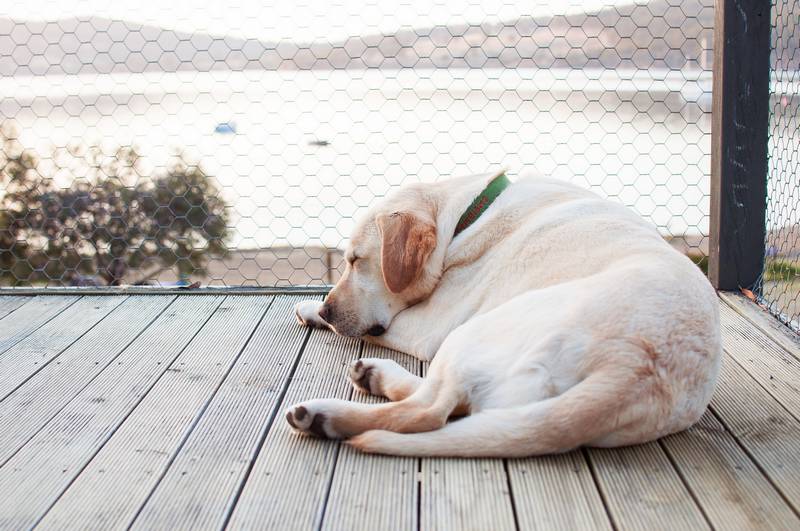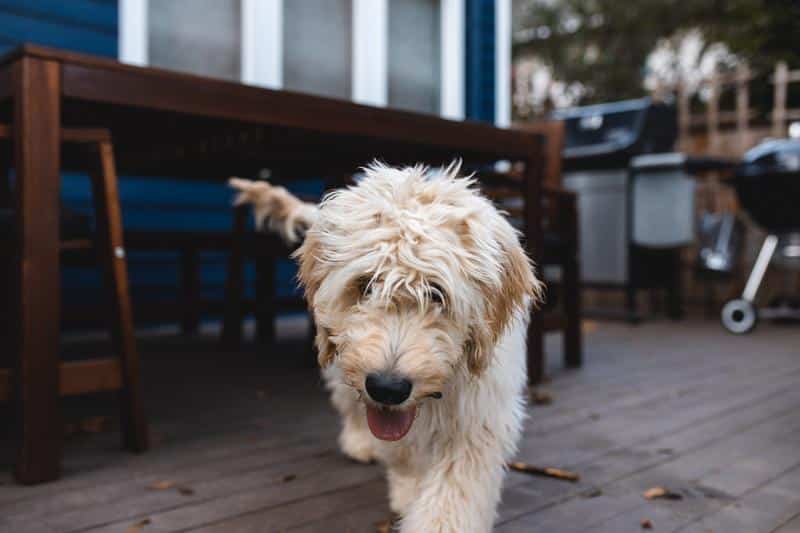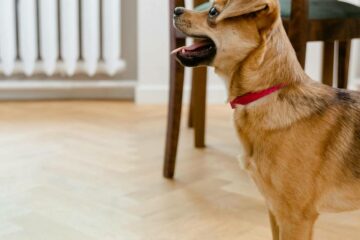Dog Peeing on Deck? How to Stop, Repel, & Remove!
Has the peaceful sanctuary of your outdoor space been disrupted by your dog peeing on the deck? Don’t worry, you’re not alone, and this is a more common issue than you might think. This guide will help you uncover the reasons behind this behavior and most importantly, reveal how to stop it.
We’re going to look at homemade urine repellents for wooden decks and discuss whether dog pee can ruin both wood and composite decking. In addition, we’ll explore strategies for managing this issue in winter and provide you with steps to remove dog urine stains from your deck. Plus, we’ll guide you on creating a dedicated potty area on your deck.
Are you ready to restore your deck to its former glory? Let’s dive in below!
How to Stop Dog Peeing on Decking

To stop dog peeing on deck:
- Immediately give a calm but firm “no” or “stop” if you catch your dog peeing on the decking.
- Clean the spot up right away so it doesn’t get absorbed.
- Bring your dog somewhere appropriate to finish peeing.
- Learn your dog’s pee schedule as best as you’re able.
- Take them on plenty of long walks around this time, and bring along treats.
- Be patient and give your dog lots of time to pee.
- Once they do, reward them immediately with praise and a treat.
- This forms a positive connection with only peeing during walks and not on your deck.
- Make sure that all others in the home are also following the steps we just went over.
- Use the following steps to stop your dog peeing on the deck.
- Make a mix of 1 part distilled white vinegar and 1 part water in a spray bottle.
- Spray this mixture around where your dog pees on the decking.
- The mixture is safe for both wood decking and composite decking, including those that have been stained.
- Wait an hour for it to dry and the smell from the vinegar will go away.
- Your dog will still be able to pick up the scent and will remain repelled from peeing on your decking.
These steps will get your dog to stop peeing on the deck, but it’s important to remember that the underlying behavioral issues (dominance and possibly anxiety) that were causing all of this to begin with will still be present. And until you address those, any positive changes you see are only going to be temporary.
“But how do I make these changes stick?”
By getting your dog to truly choose to follow your direction, that’s how. I tried many times to write out how you can do that before deciding it made more sense to just link you to the free video series that explains it better than I’d ever be able to.
The series is by a man named Dan who is one of the world’s leading dog obedience trainers. In it, he teaches you how to put an end to things like when your dog pees on the deck and all other misbehavior using his fast and easy-to-follow methods.
In the first video, Dan will reveal to you why the two most common methods of dog training only doom you to failure. You can watch the video now by clicking here. Follow the proven system he’ll show you in his series and you’ll never have to spend another second worrying about your dog peeing on the deck ever again!
Stop Dog Peeing on Deck: Why It Happens

Dogs pee on decks due to a range of reasons. They might be marking their territory, they might find the deck conveniently accessible, or they might be dealing with an underlying health or behavioral problem.
To begin with, territory marking is a typical canine behavior. It’s their way of saying, “Hey, I’m in charge here!” When a dog pees, it’s leaving a scent for other dogs to detect, essentially staking its claim on the area.
The second reason is quite straightforward: convenience. The deck could be the easiest place for your dog to relieve itself, especially when left alone for a long period or during inclement weather.
Lastly, there could be health or behavioral issues at play. Anxiety, stress, or medical conditions such as urinary tract infections could lead to your dog urinating in places you’d rather they didn’t. It’s always wise to check with your vet if the behavior seems sudden or out of character.
Let’s dive a little deeper:
- Marking Territory: This behavior is especially prevalent in male dogs. They use their pee as a signal to other dogs that this territory is occupied.
- Convenience: The deck might be the path of least resistance for your dog. It’s readily accessible, and they don’t have to venture far from home, especially during bad weather or when they’re home alone.
- Health or Behavioral Concerns: If your dog is stressed, anxious, or dealing with a medical condition like a urinary tract infection or kidney disease, they might urinate more frequently or in unusual places. A sudden change in behavior warrants a trip to the vet.
In summary, dogs pee on decks for a variety of reasons. By understanding the cause, we can start to address the behavior and work towards a solution. To learn exactly how to do that, go back to the first section of this article now.
Dog Pee on Wood Deck: Homemade Urine Repellant
Your homemade urine repellant can start with a good cleaning. Dogs are attracted to spots where they’ve peed before due to the lingering scent. So, giving your deck a thorough clean with a pet-safe enzymatic cleaner can help break down the smell and discourage your pup from re-marking the area.
Citrus is your next ally. Dogs aren’t fans of the strong smell of citrus. Soaking cotton balls in citrus juice or essential oils and placing them strategically around your deck can deter your pet. Just remember not to apply citrus oils directly on your deck as they can stain the wood.
The smell of vinegar can also be off-putting to dogs. A homemade spray of equal parts distilled white vinegar and water can work as a deterrent. It’s safe to spray directly on the deck but test it first on an inconspicuous spot to ensure it doesn’t discolor the wood.
Another useful repellant could be chili pepper. Dogs dislike the strong scent of capsicum, which is found in chili pepper. Sprinkling some chili powder or crushed dried chili peppers around your deck might just do the trick. However, be careful not to overdo it as this could irritate your dog’s nose and eyes.
Steps to Create a Homemade Urine Repellant
- Thoroughly clean the deck with a pet-safe enzymatic cleaner.
- Place cotton balls soaked in citrus juice or essential oils around the deck.
- Create a homemade spray using equal parts distilled white vinegar and water and spray it on the deck.
- Sprinkle some chili powder or crushed dried chili peppers around the deck.
Remember, these are deterrents and not solutions. Repelling your dog from the deck without addressing the root cause will just mean they’ll go in other areas. You’ll find your dog pees on the laminate flooring, pees in your car, or even pees on the kitchen floor.
If your dog keeps peeing on your deck or other areas, it might be a sign of a deeper issue, such as a medical condition or anxiety, which should be addressed with your vet or through behavioral training (go back to the first section now).
Does Dog Pee Ruin Wood Deck?
Dog pee can indeed damage a wood deck. Urine, whether from a dog or any other creature, contains high levels of nitrogen. While nitrogen is often used as a fertilizer in small quantities, in the high concentration found in urine, it can be too potent and can result in something called “urine burn.”
Urine burn can discolor wood, leaving unsightly dark spots. Over time, if not cleaned, these spots can become a breeding ground for mold and mildew due to the moisture content in the urine. This can cause the wood to soften and rot, which can lead to structural damage to your deck.
Another concern is the acidity of dog urine. The pH of dog urine generally leans towards being more acidic, which can eat away at the protective coatings or sealants on the wood. Once this protective layer is compromised, the wood becomes more susceptible to other forms of damage, such as water damage, sun damage, and insect infestation.
Now, let’s summarize:
- Urine Burn: High levels of nitrogen in dog urine can cause discoloration and burn marks on your wood deck, making it unsightly.
- Mold and Mildew: The moisture from urine can lead to mold and mildew growth if not cleaned up promptly. This can eventually cause the wood to rot and degrade.
- Acidity: The acidic nature of dog urine can strip away the protective coatings on your wood deck, leaving it vulnerable to further damage.
So yes, unfortunately, dog pee can cause quite a bit of harm to your wood deck if not addressed promptly. Learn how to stop your dog from peeing on your wood deck by going back to the first section of this article.
Will Dog Pee Ruin Composite Decking?
Dog pee generally won’t ruin composite decking, but it can cause some issues. Composite decking is a blend of wood fibers and plastic, designed to be more resistant to various environmental factors, including dog pee.
Still, it’s not totally invulnerable. Dog urine can leave unsightly stains on composite decking. While these stains might not damage the structural integrity of the deck, they can certainly detract from its aesthetic appeal. Regular cleaning can mitigate this issue.
The other potential issue is odor. If the urine isn’t cleaned up promptly, the smell can linger, creating an unpleasant environment on your deck.
Let’s summarize the potential issues:
- Stains: While dog pee won’t necessarily damage composite decking, it can leave stains. This won’t affect the deck’s structural integrity, but it can make it look less appealing.
- Odor: If not cleaned up quickly, dog pee can leave an unpleasant smell on your composite deck. Regular cleaning can help keep this issue in check.
So, while dog pee won’t ruin composite decking in the way it can damage wood, it can still cause some aesthetic and odor problems if not managed properly. If you’d like to learn how to stop your dog from peeing on your composite deck so you don’t have to worry about all of this, then go back to the first section now.
Dog Peeing on Deck in Winter
Dogs peeing on decks in winter can be quite a nuisance. Here are some reasons why this might occur:
- Unwelcoming Weather: The frigid winter weather might make your dog reluctant to go out into the yard for their bathroom breaks. As a result, the deck becomes a more attractive option due to its proximity and relative shelter from the elements.
- Snow Discomfort: If your yard is covered in snow, your dog might be unsure or uncomfortable about venturing into it. Some dogs dislike the feeling of snow under their paws or are unsure about peeing in it. In such cases, a cleared deck might seem like a safer and more familiar option.
- Scent Preservation: Cold weather can help to preserve scents. If your dog has previously urinated on the deck and the smell has lingered due to the cold, they may be more likely to repeat the behavior, thinking it’s an acceptable spot to do their business.
Understanding these reasons can help us tackle the issue more effectively. It’s all about making your dog feel comfortable and helping them understand where it’s acceptable to go to the bathroom, even when the weather outside is frightful.
How to Remove Dog Urine From Wood Deck
Removing dog urine from your wood deck doesn’t have to be a daunting task. With the right approach and tools, you can effectively clean the area and reduce potential damage.
- Immediate Cleanup: As soon as you notice the pee, clean it up using paper towels or an absorbent cloth. The quicker you remove the urine, the less time it has to seep into the wood.
- Water Rinse: After blotting up as much urine as possible, rinse the area thoroughly with water. This helps dilute any remaining urine and prevents it from soaking into the wood.
- Enzyme Cleaner: Use a pet-friendly enzyme cleaner to remove any lingering odors and stains. Enzyme cleaners break down the urine at a molecular level, eliminating both the stain and the odor.
- Let It Dry: After cleaning, let the area dry completely. This prevents moisture from becoming trapped in the wood, which can lead to mold and rot.
By following these steps, you can effectively manage dog pee on your wood deck. Remember, the key to preventing damage is prompt and proper cleanup. Find out how you can stop your dog from peeing on your deck in the first section of this article now.
Dog Potty Area on Deck: How to Create
Creating a designated potty area on your deck can save your deck from potential damage and make your life easier. Here’s a step-by-step guide on how to set this up:
- Choose the Right Spot: The area should be easily accessible to your dog but also somewhat out of the way so it doesn’t interfere with your use of the deck.
- Select the Appropriate Material: You could use a variety of materials such as artificial grass pads, pee pads, or even a litter box with absorbent material. Choose what works best for your dog and your living situation.
- Train Your Dog: Once you’ve set up the potty area, you’ll need to train your dog to use it. This might take some time and patience, but consistent training will eventually pay off.
- Maintain Cleanliness: Regularly clean the potty area to keep odors at bay and make the area more inviting for your dog to use. If the area becomes too dirty, your dog might avoid using it.
By following these steps, you can create a dog potty area on your deck that works for both you and your furry friend. Remember, every dog is different, so it might take a little trial and error to figure out what works best for you both.
I’m sure you’re sick of your deck smelling like dog pee, so I’ll let you get started on things now. Best of luck, and thank you for checking out our article “Dog Peeing on Deck? How to Stop, Repel, & Remove!”





